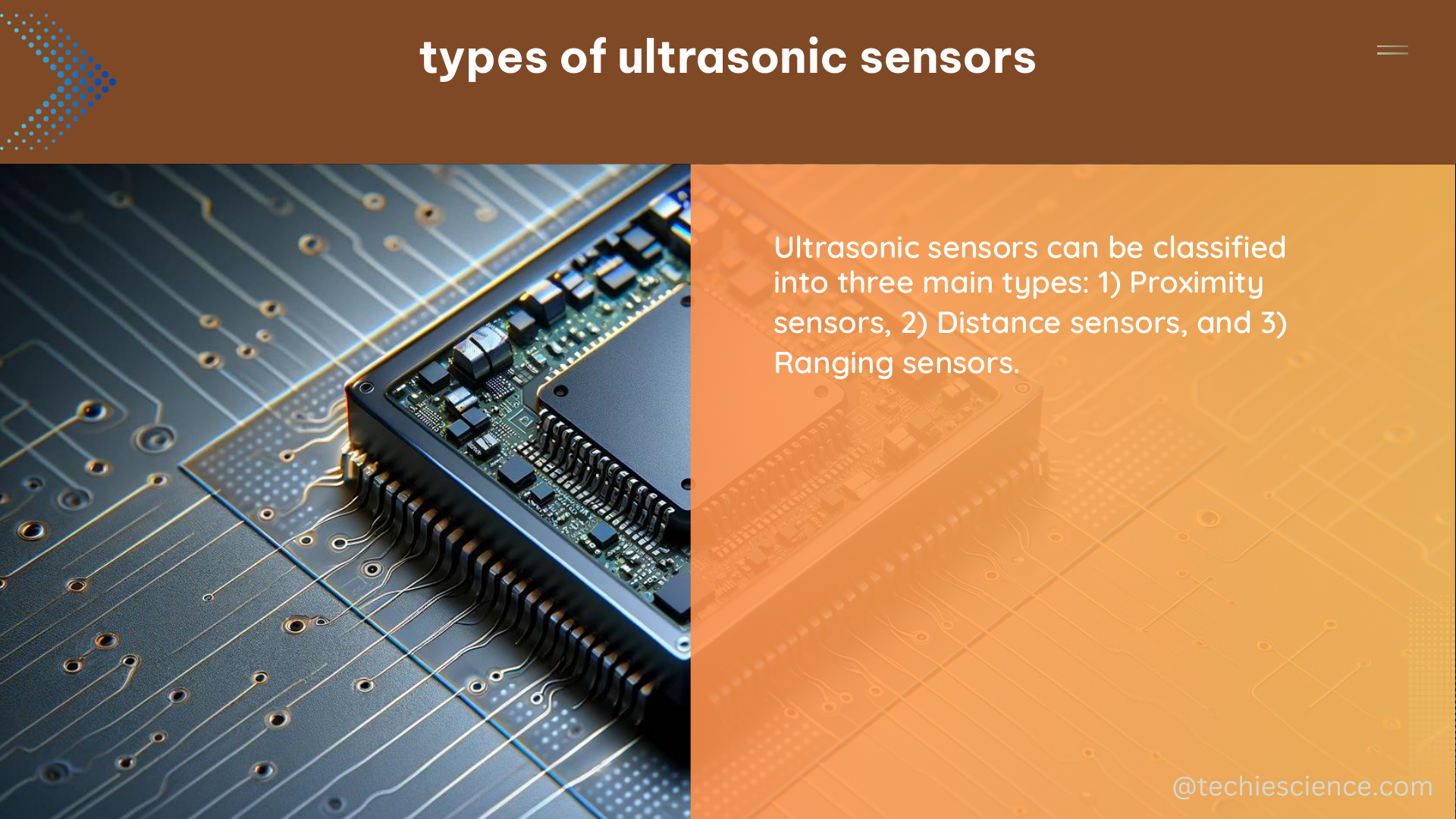Ultrasonic sensors are versatile devices that use high-frequency sound waves to detect and measure the distance to objects. These sensors are widely used in various applications, from industrial automation to home security systems. In this comprehensive guide, we’ll explore the different types of ultrasonic sensors, their technical specifications, and their applications.
Proximity Sensors
Proximity sensors are the most common type of ultrasonic sensor. These sensors are designed to detect the presence or absence of an object within a specific range, typically up to 10 cm. They work by emitting a high-frequency sound wave and measuring the time it takes for the echo to return. Proximity sensors are often used in automation and robotics applications, such as object detection, collision avoidance, and material handling.
Key Specifications:
– Frequency: Typically between 40 kHz and 400 kHz, with higher frequencies offering better resolution and shorter detection ranges.
– Detection Range: Up to 10 cm, with some models capable of detecting objects up to 30 cm away.
– Resolution: As low as 0.1 mm, allowing for precise object detection.
– Accuracy: Typically within 1-2% of the measured distance.
– Response Time: Ranging from 10 ms to 200 ms, depending on the sensor’s design and application.
Distance Sensors

Distance sensors are used to measure the distance between the sensor and an object. These sensors have a longer detection range than proximity sensors, typically up to several meters. They are commonly used in industrial automation, security systems, and transportation applications, such as level monitoring, object positioning, and vehicle parking assistance.
Key Specifications:
– Frequency: Typically between 20 kHz and 200 kHz, with lower frequencies offering longer detection ranges.
– Detection Range: Up to 10 meters, with some models capable of detecting objects up to 20 meters away.
– Resolution: As low as 1 mm, allowing for precise distance measurement.
– Accuracy: Typically within 0.1-1% of the measured distance.
– Response Time: Ranging from 50 ms to 500 ms, depending on the sensor’s design and application.
Fluid Level Sensors
Fluid level sensors are used to measure the level of liquids in tanks, containers, and pipes. These sensors work by emitting a sound wave and measuring the time it takes for the echo to return, which is then used to calculate the liquid level. Fluid level sensors are commonly used in industrial automation, water treatment, and oil and gas applications.
Key Specifications:
– Frequency: Typically between 20 kHz and 100 kHz, with lower frequencies offering better performance in turbulent or foaming liquids.
– Detection Range: Up to 10 meters, with some models capable of measuring levels up to 20 meters deep.
– Resolution: As low as 1 mm, allowing for precise level measurement.
– Accuracy: Typically within 0.1-1% of the measured level.
– Operating Temperature: Ranging from -40°C to 80°C, with some models designed for high-temperature applications.
Specialty Ultrasonic Sensors
In addition to the common types of ultrasonic sensors, there are also several specialty sensors designed for specific applications:
-
Ultrasonic Anemometers: These sensors measure wind speed and direction by detecting the time-of-flight of ultrasonic pulses traveling between transducers. They are commonly used in meteorological and environmental monitoring applications.
-
Ultrasonic Flowmeters: These sensors measure the flow rate of liquids or gases by detecting the time-of-flight difference of ultrasonic pulses traveling in the opposite direction of the flow. They are used in industrial process control, water management, and energy monitoring applications.
-
Ultrasonic Thickness Gauges: These sensors measure the thickness of materials, such as metals, plastics, and composites, by detecting the time-of-flight of an ultrasonic pulse traveling through the material. They are used in quality control, maintenance, and manufacturing applications.
-
Ultrasonic Imaging Sensors: These sensors use an array of ultrasonic transducers to create a visual representation of an object or surface. They are used in medical imaging, industrial inspection, and security applications.
Selecting the Right Ultrasonic Sensor
When selecting an ultrasonic sensor for your application, it’s important to consider the following key factors:
- Application Requirements: Determine the specific requirements of your application, such as the detection range, resolution, accuracy, and environmental conditions.
- Sensor Specifications: Ensure that the sensor’s technical specifications, such as frequency, detection range, and response time, match your application requirements.
- Environmental Factors: Consider the sensor’s ability to operate in the presence of dust, moisture, vibration, or other environmental factors that may affect its performance.
- Power Requirements: Determine the sensor’s power consumption and ensure that it is compatible with your power supply.
- Cost and Availability: Consider the sensor’s cost and availability, as well as any additional components or accessories that may be required.
By understanding the different types of ultrasonic sensors and their technical specifications, you can select the right sensor for your application and ensure optimal performance and reliability.
References
- Federal Motor Vehicle Safety Standards; Rear Visibility. (2014). Retrieved from https://www.federalregister.gov/documents/2014/04/07/2014-07469/federal-motor-vehicle-safety-standards-rear-visibility
- The Future of Sensors. (2014). Retrieved from https://aiha-assets.sfo2.digitaloceanspaces.com/AIHA/resources/Get-Involved/AIHA_Future-of-Sensors_web_updated.pdf
- Sensors for daily life: A review. (2021). Retrieved from https://www.sciencedirect.com/science/article/pii/S2666351121000425
- Intelligent Systems Using Sensors and/or Machine Learning to Mitigate Wildlife–Vehicle Collisions: A Review, Challenges, and New Perspectives. (2022). Retrieved from https://www.mdpi.com/1424-8220/22/7/2478

The lambdageeks.com Core SME Team is a group of experienced subject matter experts from diverse scientific and technical fields including Physics, Chemistry, Technology,Electronics & Electrical Engineering, Automotive, Mechanical Engineering. Our team collaborates to create high-quality, well-researched articles on a wide range of science and technology topics for the lambdageeks.com website.
All Our Senior SME are having more than 7 Years of experience in the respective fields . They are either Working Industry Professionals or assocaited With different Universities. Refer Our Authors Page to get to know About our Core SMEs.